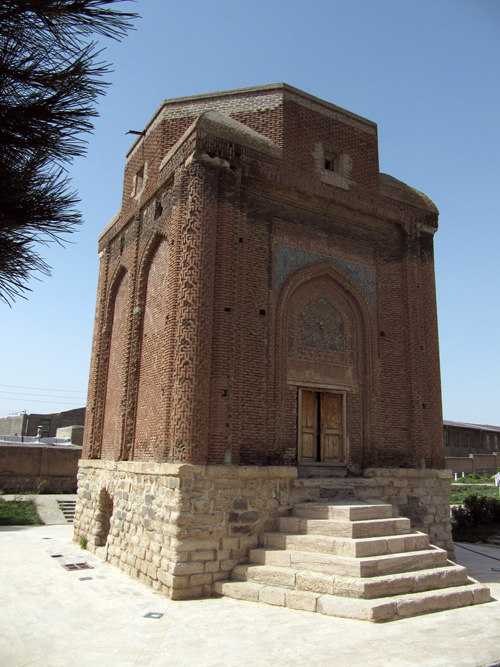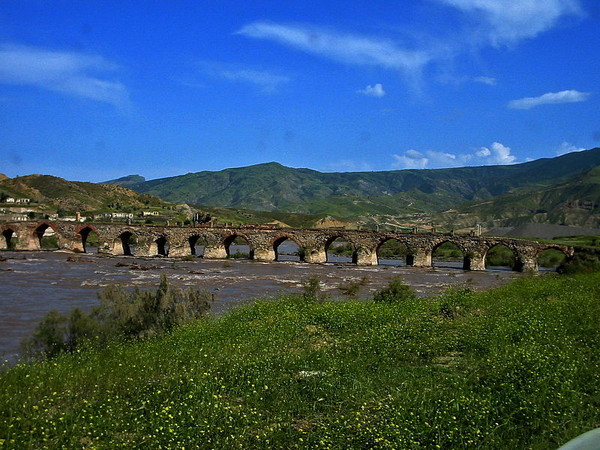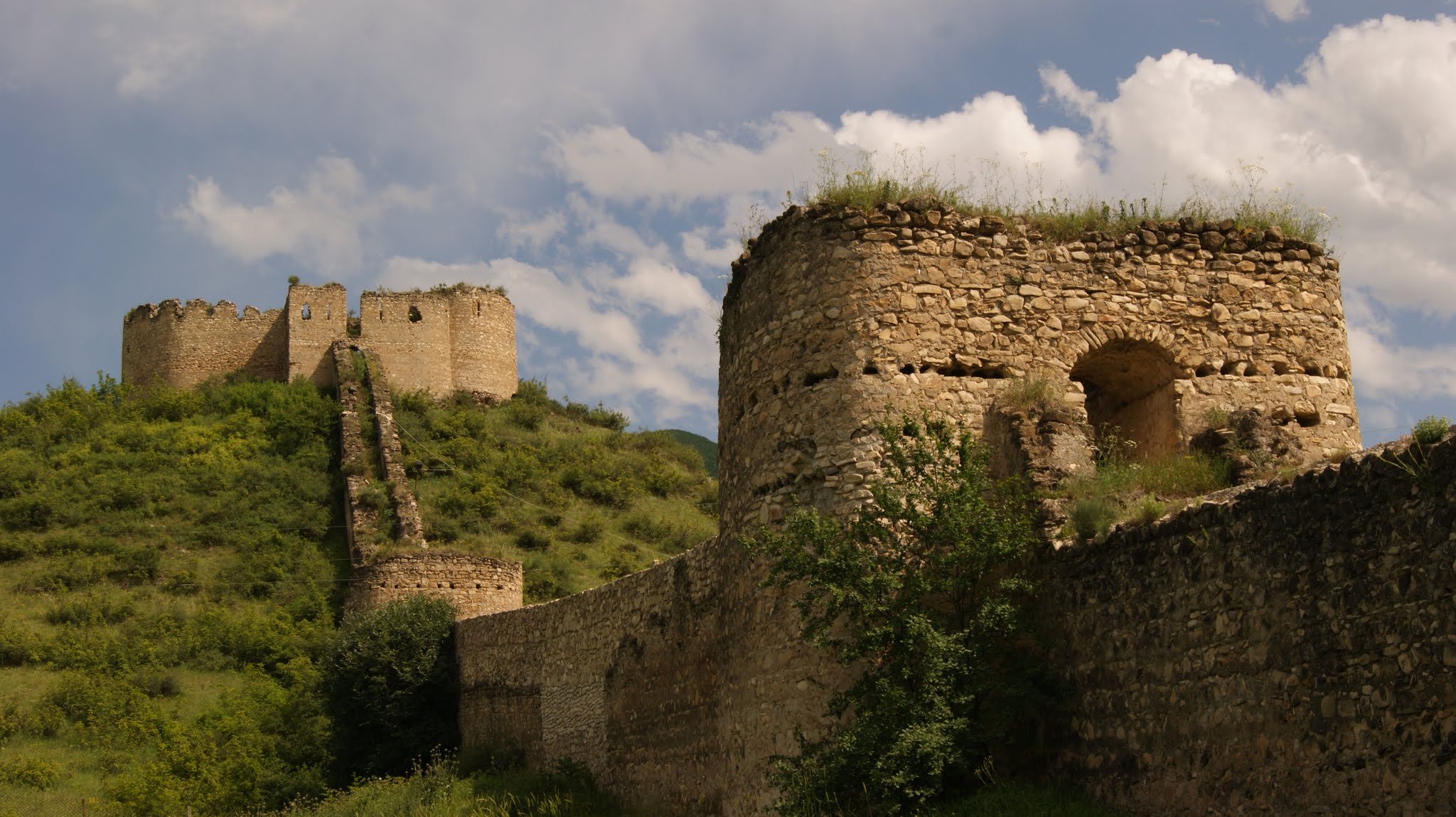DEVELOPMENT OF ARCHITECTURE IN THE MIDDLE AGES
During the rise of the Arab Caliphate, Barda became the architectural centre of Azerbaijan. Wide-scale construction works such as the construction of mosques and other religious buildings, caravanserais, markets, bath-houses and etc. were carried out in Barda, which was called "The Baghdad of these places" in historical sources.  Different architectural schools (Aran, Tabriz, Nakhicdhevan, Shirvan, Absheron) appeared in the 10-12th centuries in connection with the formation of small states after the Caliphate collapsed during the 9-10 centuries A.D. There was a common style among architectural schools of Azerbaijan. The majority of buildings, built by masters of the Aran architectural school (Ganja, Barda, Beylagan) were destroyed at the time of Ganja earthquake (1139) and Mongol invasion (XII century). Remnants of those buildings were discovered by archaeological excavations in Ganja and Beylagan. The remnants of three bridges over the River Ganja (XII century), residential buildings, bath-houses, etc., are evidencing the peculiarities of the Aran architectural school.
Different architectural schools (Aran, Tabriz, Nakhicdhevan, Shirvan, Absheron) appeared in the 10-12th centuries in connection with the formation of small states after the Caliphate collapsed during the 9-10 centuries A.D. There was a common style among architectural schools of Azerbaijan. The majority of buildings, built by masters of the Aran architectural school (Ganja, Barda, Beylagan) were destroyed at the time of Ganja earthquake (1139) and Mongol invasion (XII century). Remnants of those buildings were discovered by archaeological excavations in Ganja and Beylagan. The remnants of three bridges over the River Ganja (XII century), residential buildings, bath-houses, etc., are evidencing the peculiarities of the Aran architectural school.
Monuments of the Nakhichevan architectural school differ by the bashtagh composition with multi-coloured glazed ornaments, while the buildings belonging to Shirvan-Absheron school stand out for their simple architectural elements and decorative engraving ornament. The magnificence of architectural structure and decor difference are typical for the best monuments of the Tabriz school.
Style peculiarity of the Nakhichevan school reflected on tower-shaped mausoleums with rich decor and proportionate structure and other buildings, preserved till nowadays. The peak of this school presents Adjami Abubakr oghlu Nakhichenai's creation, the author of mausoleums Yusif ibn Kuseyr (1186) and Momina Khatun (1186) in Nakhichevan, as well as a destroyed religious building complex. Character monumentality, composition proportionate and decor weakness, rational construction for his time, ornament playfulness is typical for his creation. His ornamental composition based on the organic unity of art and mathematic thinking. Adjami's composition and decorative ornament styles influenced on mausoleums of certain countries. Mausoleum "Goy gunbaz" in Maragha (Blue cupola -architect Ahmad Mahammad oghlu,1196) is particularly close to Adjami's style. Maragha monuments occupied an important place in the development of Azerbaijan architecture. Some of them, preserved till nowadays, are mausoleum "Girmizi gunbaz" (Red cupola - architect Bakir Mahammad,1148). Mausoleum "Uch gunbaz" (Three cupolas - architect Abu Mansur Mahammad,1185), built-in Urmiya in this period, is close to Maragha monuments by its architectural structure.
Architectural styles, formed in the brick buildings of the Nakhichevan school, reflected on stone mausoleums such as Gulustan near Juga village, Nakhichevan AR (early XIII century), Seykh Babi Yagubi in Babi village (1273-1274, architect presumably Ali Madjidi) and Mirali in Ashagi Veysalli, Fuzuli region (XIII-XIV centuries). Because of similarity between mausoleums in Barda (architect Ahmad ibn Ayyub al-Hafiz Nakhichevani,1322) and Garabaglar village, Nakhichevan AR (early XIV century) and time of their construction show that they were built by the same architect.
Names of many Azerbaijan architects, mason and architectural ornament masters of X-XII centuries are preserved in different building inscriptions, stone flags, decorative ornamental wares and other sources till nowadays. Mahammad ibn Jafar (inscription in graveyard "Peygamber" (Prophet) of X century in Beylagan region), Ibrahim ibn Osman (Gandja gates, 1063), Mahammad Abubakr oglu (Siniggala mosque in Baku, 1078), Mohsun (XI century, works are unknown), his son Bandan ibn Mohsun (XII century, works are unknown), his grandchild Bakir Mahammad ("Girmizi gunbaz" mausoleum (Red cupola) in Maragha, 1148), Adjami Abubakr oglu Nakhichevani (Yusif ibn Kuseyr mausoleum in Nakhichevan, 1162, Momina Khatun mausoleum, 1186 and etc.), Ashur Ibrahim oglu (stone sanctuary of Ibrahim mosque in Icharishahar, 1171), Amiraddin Masud (XII century, works are unknown), Abu Mansur Musa oglu ("Uch gunbaz" mausoleum (Three cupolas) near Urmiya, 1185), Ahmad Mahammad oglu ("Goy gunbaz" mausoleum (Blue cupola) in Maragha, 1196), Masud Davud oglu (Maiden tower in Baku, XII century), Jamalladdin (mausoleum in Alichay khanagah (abode) Khanaga village, Nakhichevan AR, late XII century-early XIII century), Ahmad Abulbak oglu Castle in Mardakan (works are unknown, XII century, Marand), Abdulmadjid Masud oglu (Round castle in Mardakan, 1232), Zeynaddin Aburashid oglu Shirvani ("Bayil castle" apartment of Shirvanshahs in Baku port, 1235), Badraddin Tabrizi (Jalaladdin Rumi mausoleum in Konya city ,Turkey, 1273), Mahammad ibn Mahmud (mosque minaret in Amasiya city, Turkey, 1246), Mahmud ibn Magsud (minaret of Pirsaatchay khanagah (abode), 1256) Mahmud ibn Masud (Shafiulla mosque in Baku; XIV century), naggash Abdulmomin Shafarshah oglu (engraving ornament of mosque sanctuary in Tabriz, Urmiya, 1277), Mahmud Sad oglu (castle in Nardaran village near Baku, minaret of Bibiheybat mosque, 1305-1313), Ahmad ibn Ayyub al-Hafiz Nakhichevani (Barda mausoleum, 1322), gaktarash Nizam Bandgir (engraving ornament of Juma mosque in Marand city, 1329), Hadji Mahammad (caravanserai in Isfahan, Tabriz, 1331), Sahbanzar (mausoleum in Khachindarbatli, Agdam region, 1314), Kashrasif Musa oglu (Khan bath-house in Nardaran, 1388) and etc. created the most valuable patterns of Azerbaijan architecture in X-XIV centuries.
 Grand bridges were built in Azerbaijan in XII-XIII centuries. Some of them are Khudaferin bridges with 15 spans (XII century) and 11 spans (XIII century) over the River Araz, Broken bridge with 4 spans in present Gazakh region (Red bridge, XII century), 3 bridges built over the River Gandjachay (remains, XII-XIII centuries), bridge over the River Giziluzan near Minaya town, Southern Azerbaijan ("Maiden bridge", XII century) and etc. particularly draw attention.
Grand bridges were built in Azerbaijan in XII-XIII centuries. Some of them are Khudaferin bridges with 15 spans (XII century) and 11 spans (XIII century) over the River Araz, Broken bridge with 4 spans in present Gazakh region (Red bridge, XII century), 3 bridges built over the River Gandjachay (remains, XII-XIII centuries), bridge over the River Giziluzan near Minaya town, Southern Azerbaijan ("Maiden bridge", XII century) and etc. particularly draw attention.
Stone constructions, volume-to-space laconism of the architecture, engraving plant ornament on stone are typical for Shirvan-Absheron architectural monuments, passed long development way. Sinniggala minaret in Baku (Mahammad Abubakr oghlu, 1078), Maiden tower (architect Masud Davud oghlu, XII century), Mardakan towers (Round tower, architect Abdulmadjid oghlu, 1232; Four-cornered tower, XIV century), Nardaran tower (architect Mahmud Sad oghlu,1301), Ramana tower (XIV century) and etc. are the best monuments of this school. "Bayil castle" of Shirvanshahs, built-in Baku port in the XIII century and remained underwater, is one of the most interesting buildings of this period. This building complex, surrounding with tower walls with stone engravings, script and pictures on it (1235, master Zeynaddin Aburashimd oghlu Shirvani and presumably architect Abdulmadjd Masud oghlu), is a rare architectural ensemble. Pirsaatchay khanagah (abode) formed in XIII-XIV centuries is one of the buildings belonging to the Shirvan-Absheron architectural school. Construction date (1256) and name if its architect (Mahmud ibn Magsud) preserved on the minaret of this religious complex, built around Pir Huseyn mausoleum. Mature period of the Shirvan-Absheron architectural school is reflected in Diribaba mausoleum in Maraza (1402), Sheykh Guneyd mausoleum in Hazra village, Gusar region (1544) and Shirvanshahs palace complex in Baku (1420-60).
Birth of Elkhani state in the middle of the XIII century caused certain reanimation in architecture... Maragha observatory was built in the ruling period of Hulaku khan (1256-65), the founder of Elkhani dynasty. Tabriz city became the center of architecture and art in connection with the removal of the capital to Tabriz city. Towns such as Arguniya, Gazaniya, Rashidiyya were built around Tabriz.
The political and economic life of Azerbaijan concentrated in the south of the country in connection with the birth of Safavis state and declaring Tabriz the capital, as well as losing the administrative centre significance of Shirvan in the late XV century - early XVI century. Art traditions reached a new development stage due to town expansion. Position of Tabriz in Azerbaijan architecture particularly strengthened.
Azerbaijan architects and naggashes worked in other countries, created interesting art patterns in XV-XVI centuries. "Signatures" of Azerbaijan architects remained on architectural monuments in Bursa, Cairo, Baghdad, Damirgapi (Darband), Herat, Samarkand and etc. The graceful gates of Green Mausoleum in Bursa city (1420-21) were made by Azerbaijan master Ahmad Tabrizi. Tabriz masters decorated sanctuary of Green mosque in Bursa (1424) with porcelain made by their arms. Ali Tabrizi (was known under the names Captive Ali, Adjam Ali), the Azerbaijan architect took to Istanbul by Sultan Salim I after Chaldiran battle (1514), built general arch of Topkapi palace and Sultan Salim mosque in Istanbul (1522).
XVI-XVII centuries were a continuation of old traditions. Different town-building works were carried out in the territory of Southern Azerbaijan in XVI century. XVII century is significant with the development of towns and the creation of central complexes in those towns.
Construction of different buildings spread due to trade development in XVII-XVIII centuries. Caravanserais were built in Shamakhi, Ganja, Baku, closed markets in Ardabil (Geysariya market) and Tabriz, as well as religious and residential constructions. Residence constructions, mosques, caravanserais and trade buildings took an important place in the structure of Azerbaijan towns of that time.
Bath-houses were widely spread in Azerbaijan towns as in other Feudal East towns. Bath-houses served as places of rest, meeting, conversation and table game, as well as ceremonies along with sanitaria-hygiene. The best examples of Azerbaijan bath-houses remained in Nardaran village, Absheron, (1388, architect Kashtasif Musa oghlu), Icharishahar part of Baku (Qasimbey bath-house, XIV century, Hadji Qayib bath-house, XV century), Basgal (XVII century), Ganja ("Hollow bath-house ", XVII century), Shusha ("Merdinli" bath-house), Quba ("Hollow bath-house ), Shaki ("Agvanlar bath-house" XIX century), Agdam (bath-house of Abdal Gulabli village, architect Kerbalayi Safikhan Qarabagi,1900).
The disintegration of Azerbaijan into separate khanates and economical disorderliness of the country caused stagnation in architectural and construction development in the XVIII century. In separate cases, architectural solution lag is observed in the architecture of buildings, elevated on a base of old traditions. The turning point appeared in the town-building along with this. Big towns and residential places became administrative and art centres of khanates.
Asgaran tower, built by Nagorno-Karabakh khan Panahali (then was expanded by Ibrahim khan), is the largest defence building of that time. Asgaran tower, elevated on the right and left banks of the River Gargar, is consisted of two fortifications.
Interesting examples of popular residence constructions of XVIII-XIX centuries remained in Zagatala, Shaki, Ordubad, Shusha, Guba, Gonagkand, Ganja and Absheron.
Azerbaijan architects, masons and masters such as Ustad Hadji's son (architect; Diribaba mausoleum in Maraz, 1402), Mahammad Madjid Tabrizi (naggash; sanctuary of the Green basin , 1424), Ali ibn Hadji Ahmad (master of engraving on wood; gates of basin in Bursa), architect Ali (Mahammad Ali; mausoleum of 1435 Shirvanshahs complex in Baku), Hadji Ahmad (architect ; "Gates of fourties" in Darband and Big mosque, XV century), Yusif ibn Ustar Zahir (architect ; Sheykh Badraddin mausoleum in Hazra village, Gabala region, 1446), Tadjaddin (architect; Quba region; 1446), Hodja Ali Hasil Tabrizi (architect; school building of Musalla ensemble in Herat, XV century), Shamsaddin (architect; Shah mosque in Mashad, 1451), Neymatulla Bavvab ibn Mahammad (calligrapher and glaze master; inscriptions of Goy mosque in Tabriz,1465), Shamsaddin Tabrizi (architect; Ali mosque in Isfahan, 1522), Shamsaddin Shamakhi (architect; Sheykh Mansur mausoleum in Hazra village, Gabala region, 1570), Captive Ali (Tabriz; many building were constructed in Turkey (Istanbul, Konya, Askishahar, Chorlu, Tekirdag, Qabza, Trabzon, Hadjilar), Bulgaria (Sofia), Yugoslavia (Sarajevo) and other cities in 1515-37 years; main works are 2nd general arch of Topgapi palace in Istanbul, Sultan Salim mosque, 1522; Sayfaddin Qazi mosque Sofia, mansion libraries, mosque complex, in Sarajevo, 1532; Herdsman Mustafa mosque in Gabza and etc..) Amirshah Valyankuhi (architect; stone engraving general arch of Eastern gates Shirvanshahs palace ensemble in Baku, 1584), Sheykh Bahaddin (architect and scientist; Juma mosque in Candja and architectural ensemble around it, 1606), Nadir Ali ibn Master Yarali (architect; mausoleum, XVII century), Parviz (architect; mausoleum in graveyard of Buzovna village, Absheron, 1641), Ismayil Naggash Ardebili (calligrapher and naggash; ornament of general arch of Ali gates of Sheykh Safiaddin complex in Ardabil, 1647), Yusifshah ibn Malik Safimai (architect; general arch of Ali gates in Sheykh Safiaddin complex, 1647), Baba Sheykhidjan (architect; caravanserai in Maraza village, 1613), Murad Ali (architect; Hadji Bakhshi mosque in Nardaran, 1663), Abdulazim Sahkar (architect; mausoleum complex in Kalakhana village, Shamakhi region, XVII century), Baba Ali (architect; bath-house in Mammadli village, Abshero, 1663), Maharram (architect; mosque in Bina village, Absheron, 1697), Bunyad (architect; mosque in Mashtaga village, Absheron, 1716), Abbasgulu (architect and naggash; celling ornament of big salon in Shaki khan palace; XVIII century) and others created in XV-XVIII centuries.



